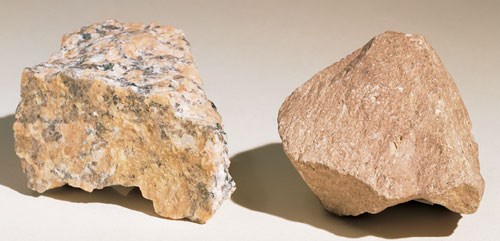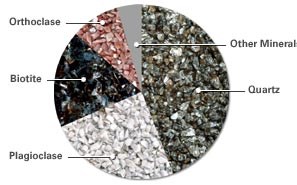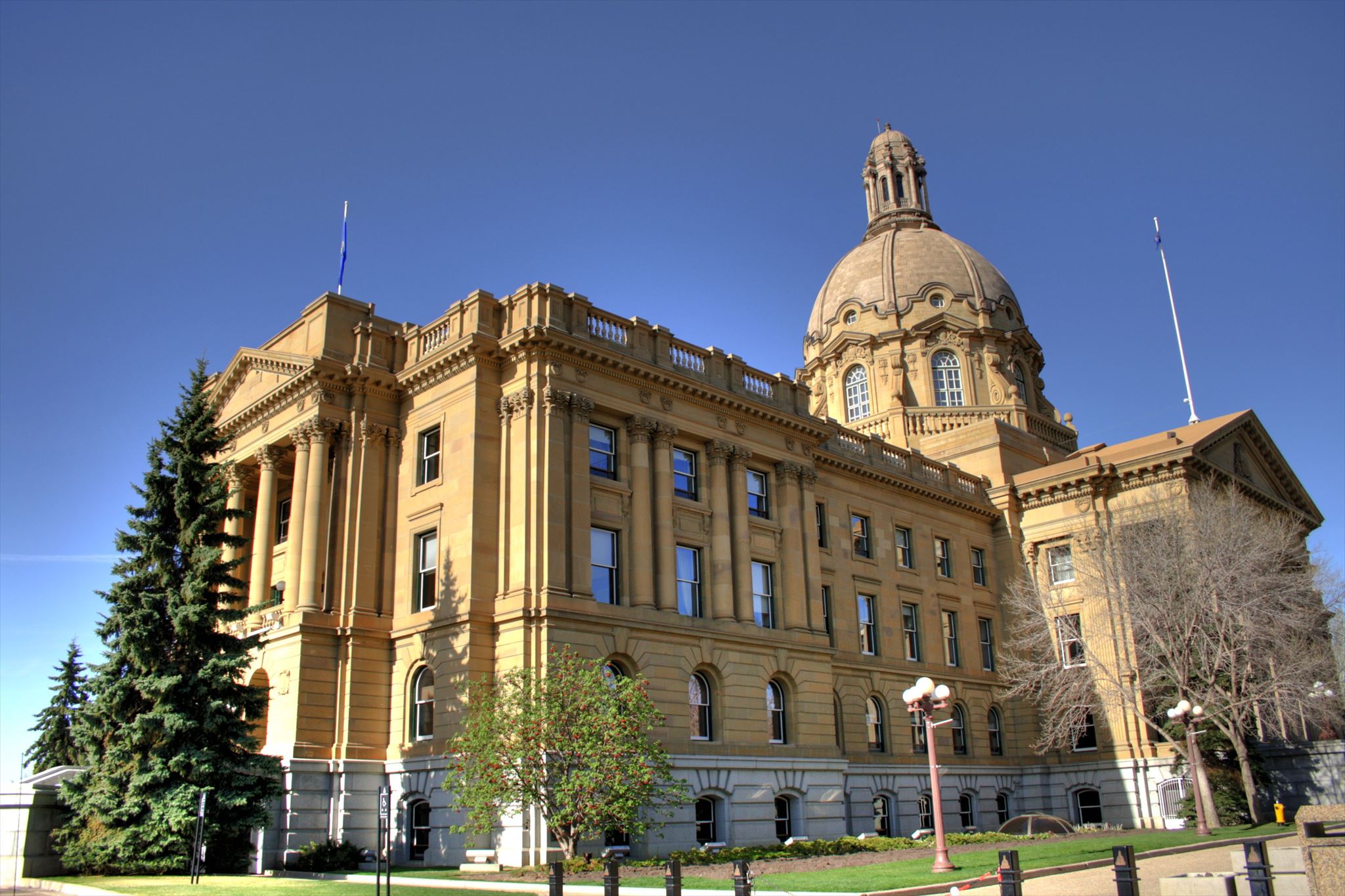Different Types of Rocks
There are three classifications of rocks:
- Igneous
- Metamorphic
- Sedimentary
Igneous
Igneous rocks put simply are cooled molten rock. Magma is molten rock beneath the Earth's surface and due to the magma's slow cooling, intrusive igneous rocks form and are characterized by large crystals due to extended cooling time. An example of an intrusive rock is granite. Extrusive igneous rocks form when lava on the Earth's surface cools rapidly and small or no crystals form. Examples of extrusive rocks are basalt or obsidian.
Igneous rocks are rare in Alberta and are only really found near Waterton National Park or in the far northeast of the province. Chunks of igneous rocks can also be carried long distances by glaciers and be deposited in locations where there are no other examples of igneous rock around (Mussieux and Nelson, 1998).

Granite is an intrusive rock (large crystals) shown on the left while Rhyolite is an extrusive rock shown on the right with small crystals.

You get different colours of granite depending on the chemical composition.
Sedimentary
There are three classifications of sedimentary rocks and 90% of Alberta's bedrock is of the sedimentary class (Mussieux and Nelson, 1998). Sedimentary rocks are fragments (or clasts) of other rocks compressed under pressure to form a new mix of rock such as sandstone, shale, or conglomerate. Sedimentary rocks can also be chemical in nature, where saline solution evaporates to leave salt behind as halite or the skeletons of tiny marine animals are compressed to form into limestone (Mussieux and Nelson, 1998). The third type of sedimentary rock is of the organic class and coal falls under this classification. Examples include soft coal and Anthracite (hard coal).

The Alberta Legislature Building is made of Paskapoo Sandstone.
Metamorphic
Metamorphic rocks can be considered a hybrid of igneous and sedimentary rocks. They are generally existing rocks that are compressed under immense heat and pressure to be partially melted but also have their chemical composition changed slightly. Due to the high level of compression and partial melting, these rocks are very hard and tough. These rocks are found in the southern rocky mountains of Alberta, around Jasper, and in the northeast of the province in the Canadian Shield. Examples of these rocks are Gneiss and Quartzite (Mussieux and Nelson, 1998).
The Royal Alberta Museum (RAM)
The interior and exterior of the museum contains all three types of rock:
- Limestone - sedimentary (on the interiors of the foyer and exteriors of the whole building)
- Marble - metamorphic (on the walls of the lobby)
- Gabbro - igneous (the floor of the lobby)
The limestone is of a variety called Tyndall Limestone, quarried in Tyndall, Manitoba. The limestone was formed at the bottom of an ancient sea covering Manitoba and is comprise of the skeletons of marine animals. You can see their fossils in the lobby! The limestone is golden in colour and is mottled with darker portions where the limestone has been converted to dolomite. Dolomite forms when existing limestone deposits are converted due to calcite (CaCO2) in carbonate mud or is modified by magnesium-rich groundwater.
Marble is limestone that has been compressed under immense heat and pressure. Due to the changes in the rock, any evidence of fossils in the previous limestone has long since been destroyed. Due to its high density and composition, it is a very tough material. However this material is still vulnerable to acid rain, therefore pollution poses a danger to our buildings and monuments.
Finally the floor of the museum is made of Gabbro. Chemically it is virtually the same as basalt, however it is an intrusive rock, therefore crystals are visible. This type of igneous rock is of the mafic type, meaning that it is high in iron content which gives it its dark colour.
Government House
This house served as the official residence of the Lieutenant Governor for 25 years and serves as a museum today.
The whole house is made of Paskapoo Sandstone, a common type of rock found right here in Alberta. In fact the sandstone used in this building and the legislature was likely quarried in Calgary. This durable, erosion-resistant sandstone was also used in the construction of the legislature building.
This sandstone was formed from sand deposited in ancient river deltas near the Rocky Mountains and was later cemented together with minerals and pressure to form the stone.
The Abstact Fountain
The wall surrounding the reflecting pool is comprised of Granite, an igneous rock. This rock was also formed deep inside the earth where the magma was permitted to cool slowly and therefore allow large crystals to grow. It is a tough and durable rock due to its interlocking crystal structure.
The Courtyard
The courtyard is paved with siltstone quarried near Canmore. It is virtually the same as sandstone except that the grains are much finer. This is a marine siltstone meaning that it was formed on the bottom of an ancient sea 180 million years ago. Depending on where you look you can see ripple marks and the fossils of ancient marine animals.
To Log This Earthcache
Submit the answers to me through my geocaching.com profile (ideally with the new messenger in the top right) and NOT in your log. Any logs without an accompanying e-mail without answers will be deleted without warning.
Please refrain from posting pictures with your log. They help armchair loggers!
The answers to these questions are either at the cache site or on this cache page.
1.) Foyer -Tell me what fossils you identified in the wall of the lobby. The more the better! POST NO PICTURES!
2.) Foyer -How are the limestone in the building's walls related to the marble in the lobby? Describe the appearance of the marble.
3.) Foyer -What cause the darker "mottling" in the limestone walls?
4.) Foyer -How old are the fossils?
5.) Lobby -What class of igneous rock is the floor of the museum's lobby made of?
6.) Government House -Where was the Paskapoo Sandstone quarried?
7.) Fountain -Does the fountain contain more plagioclase or orthoclase feldspar?
8.) Courtyard -Can you see any fossils in the siltstone? If you see fossils you CAN post them.
Please refrain from posting pictures with your log. They help armchair loggers!
References
Granite/Rhyolite Comparison [jpeg]. (2014, October 20). Retrieved from http://baughhds.weebly.com/6th-grade-science.html
Musieux, R., & Nelson, M. (1998). A Traveller's Guide to Geological Wonders in Alberta. Edmonton, AB: Provincial Museum of Alberta.
The Alberta Provincial Legislature Building, Edmonton, Alberta, Canada. [jpeg]. (2008, May 17). Retrieved from http://en.wikipedia.org/wiki/File:Legislature-Building-Edmonton-Alberta-Canada-05.jpg
This geocache is owned and maintained by a proud GEAA member.

GEAA provides general information about geocaching, encourages newcomers, and promotes the hobby of geocaching through fellowship, education, and advocacy with land managers and government.
As the geocache owner, I affirm that the image above links to a local geocaching group that is active in the community and contributing to geocaching in a positive way. The link has not been checked by Geocaching HQ or by the reviewer.